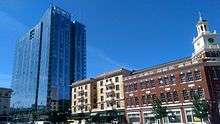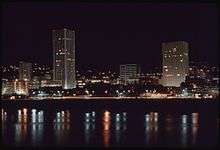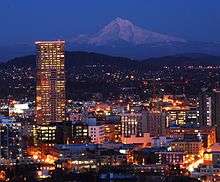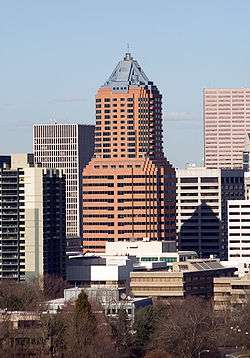Downtown Portland, Oregon
| Downtown | |
|---|---|
| Neighborhood | |
|
| |
 Downtown | |
| Coordinates: 45°31′10″N 122°40′47″W / 45.51935°N 122.67962°WCoordinates: 45°31′10″N 122°40′47″W / 45.51935°N 122.67962°W | |
| Country | United States |
| State | Oregon |
| City | Portland |
| Government | |
| • Association | Downtown Neighborhood Association |
| Area | |
| • Total | 1.00 sq mi (2.58 km2) |
| Population (2000)[1] | |
| • Total | 9,965 |
| • Density | 10,000/sq mi (3,862/km2) |
| Housing[1] | |
| • No. of households | 6384 |
| • Occupancy rate | 89% occupied |
| • % households renting | 92% renting |
| • Avg. household size | 1.56 persons |

Downtown Portland, the city center of Portland, Oregon, United States, is located on the west bank of the Willamette River. It is in the northeastern corner of the southwest section of the city and where most of the city's high-rise buildings are found.
The downtown neighborhood is defined[2] to extend west from the Willamette to Interstate 405, and south from Burnside Street to just south of the Portland State University campus (also bounded by I-405). (The northeastern portion of this area is also part of the Old Town Chinatown neighborhood.) High-density business and residential districts near downtown include the Lloyd District, across the river from the northern part of downtown, and the South Waterfront area, just south of downtown in the South Portland neighborhood.
Portland's downtown features narrow streets—64 feet (20 m) wide—and square, compact blocks 200 feet (61 m) on a side,[3] to create more corner lots that were expected to be more valuable. The small blocks also made downtown Portland pleasant to walk through. The 264-foot (80 m) long combined blocks divide one mile (1.6 km) of road into exactly 20 separate blocks.
By comparison, Seattle's blocks are 240 by 320 feet (73 m × 98 m), and Manhattan's east-west streets are divided into blocks that are from 600–800 feet (183–244 m) long.[4]
Urban development


| “ | Every great civilization has an origin story. For modern Portland, it is an exodus from Moses. That's Robert Moses, the master builder of New York City's grid of expressways and bridges .... In 1943, the city of Portland hired Moses to design its urban future... | ” |
| — Willamette Week[5] | ||
By the early 1970s, parts of Portland's central city had been in decay for some time. New suburban shopping malls in the neighboring cities of Beaverton, Tigard, and Gresham competed with downtown for people and money. Unlike many downtown revitalization efforts around the United States at this time, Portland's plan did not call for widespread demolition and reconstruction. However, the creation of a downtown transit mall in 1977, a new waterfront park in 1978 (later named after Governor Tom McCall) in place of a freeway, the creation of the Pioneer Courthouse Square in 1984, the opening of the Portland–Gresham light rail line in 1986, and the opening of Pioneer Place mall in 1990 successfully drew or retained businesses and lured customers. Downtown, which had been a virtual ghost town after regular business hours, became more of an all-hours shopping, dining, and business venue. During the two decades starting in 1990, downtown Portland dominated city development, with 500,000 square feet (46,000 m2) more development there than on the east side (Lloyd District, Central Eastside Industrial District, and Lower Albina).[6]
Downtown development has not been without criticism. Some charge that the transit mall and increased pedestrian traffic has attracted transient and homeless persons from across the city, and aggressive panhandling has increased, despite periodic police crackdowns. Downtown also has numerous surface parking lots,[7] which contradict the city's efforts to promote higher density and create the storefronts needed for a vibrant downtown. Some changes are being made slowly, such as the creation of the Smart Park garage system, and conversion of a surface-level parking lot into a park with underground parking at Park Block 5 between the Fox Tower and Park Avenue West Tower.
Bridges
Portland is sometimes known as "Bridgetown,"[8] due to the number of bridges that cross its two rivers. There are nine bridges entering downtown and immediately adjacent areas. The bridges are (north to south):[9]
- Fremont Bridge, carrying I-405 past the Pearl and Northwest districts and into downtown
- Broadway Bridge, connecting the Lloyd District to Old Town Chinatown and carrying the Portland Streetcar's east-side line
- Steel Bridge, the only double-deck bridge with independent lifts in the world,[9] and carrying MAX Light Rail and Amtrak into Old Town Chinatown
- Burnside Bridge, connecting the east side to downtown and the Old Town Chinatown neighborhood
- Morrison Bridge, leading directly into the central business district from the east side
- Hawthorne Bridge, Portland's oldest highway bridge and, leading directly into the central business district from the east side; Oregon's most heavily used bridge for bicycles
- Marquam Bridge, a two-deck bridge carrying I-5 traffic
- Tilikum Crossing, Portland's newest bridge, limited to public transit, bicycles, pedestrians, and emergency vehicles
- Ross Island Bridge, which connects U.S. Route 26 (SE Powell Blvd.) to the South Waterfront
Outside the downtown area there are three other road bridges within Portland limits that cross the Willamette River: the St. Johns Bridge and Sauvie Island Bridge (to the north) and the Sellwood Bridge (to the south).
Transportation
Most streets in downtown Portland are one-way. Naito Parkway (two-way, formerly known as Front Avenue) is the farthest east, while most of the high-rises end by I-405 to the west. Interstate 5 runs on the opposite bank of the river, crossing over on the Marquam Bridge. U.S. Route 26 connects downtown Portland to the Oregon Coast and the Cascade Range.
Downtown is also served by several forms of public transportation. TriMet, the regional mass transit agency, operates MAX light rail on two alignments in downtown, one running east/west on Yamhill and Morrison streets and north/south on 1st Avenue, the other running north/south on 5th and 6th avenues. On the latter two streets, an extensive transit mall—known as the Portland Mall—limits private vehicles and provides connections between more than fifty bus lines, MAX light rail, and the Portland Streetcar.
The southern part of downtown and the West End are also served by the Portland Streetcar system, operating from South Waterfront north into the Pearl and Northwest Portland districts. The system currently has two routes, measuring 7.2 miles (11.6 km) end to end, and connects in South Waterfront with the Tram (aerial cableway) to Oregon Health & Science University (OHSU).
Starting in 1975 and continuing for almost four decades, all transit service in downtown was free, as downtown was entirely within TriMet's Fareless Square, which also covered a portion of the nearby Lloyd District after 2001. However, in 2010, free rides became limited to MAX and streetcar service – no longer covering bus service – and the zone renamed the "Free Rail Zone",[10] and in September 2012 the fareless zone was discontinued entirely, because of a $12 million shortfall in TriMet's annual budget.[11]
Sites of interest
- Pioneer Courthouse Square
- Arlene Schnitzer Concert Hall
- Portland Art Museum
- Portland State University
- Oregon Historical Society
- Tom McCall Waterfront Park
Buildings

Several high-rise buildings are located in downtown Portland.[12] The five tallest are:
- Wells Fargo Center: rises to 166 meters (546 feet) and was constructed in 1972
- U.S. Bancorp Tower: rises to 163 meters (536 feet) and was constructed in 1983
- KOIN Center: rises to 155 meters (509 feet) and was constructed in 1984
- Park Avenue West Tower: rises to 153 meters (502 feet) and was constructed in 2016
- PacWest Center: rises to 127 meters (418 feet) and was constructed in 1984
Adjacent districts
- Old Town Chinatown – northeast, and extending south of West Burnside St. near the river
- Pearl District – north, adjacent to Chinatown
- Goose Hollow – residential, west of PSU, north of US 26
- Southwest Hills – residential, west of PSU, south of US 26
- Marquam Hill (colloquially "Pill Hill") – south, including OHSU and the Veteran's Hospital
- RiverPlace – at southeast corner of downtown
- South Waterfront – south of downtown, east of Interstate 5
See also
References
- 1 2 Demographics (2000)
- ↑ "Portland Maps: Downtown". City of Portland:Portland Maps. Retrieved 2016-07-08.
- ↑ MacColl, E. Kimbark. The Growth of a City: Power and Politics in Portland, Oregon 1915–1950. Portland, Oregon: The Georgian Press. p. 2. ISBN 0-9603408-1-5.
- ↑ "Beloved and Abandoned: A Platting Named Portland". Planetizen.com. Retrieved 2016-07-08.
- ↑ Mesh, Aaron (November 5, 2014). "Feb. 4, 1974: Portland kills the Mount Hood Freeway". Willamette Week. Retrieved 2014-11-21.
Every great civilization has an origin story. For modern Portland, it is an exodus from Moses. That’s Robert Moses, the master builder of New York City’s grid of expressways and bridges who brought the Big Apple its car commuters, smog and sprawl. In 1943, the city of Portland hired Moses to design its urban future. Moses charted a highway loop around the city’s core with a web of spur freeways running through neighborhoods. The city and state embraced much of the plan. The loop Moses envisioned became Interstate 405 as it links with I-5 south of downtown and runs north across the Fremont Bridge.
- ↑ Jackson, Reed (July 16, 2012). "Perceptions of Portland's east side changing". Daily Journal of Commerce. Retrieved 2012-07-23.
Before the mid-1990s, development on the east side was sparse; and even then, large construction projects were rare. Between 1990 and 2010, 500,000 more square feet of development took place in downtown than in the east side’s Lloyd District, CEID and Lower Albina area combined, according to data collected by the Bureau of Development Services.
- ↑ "State of Parking 2015". City of Portland. Retrieved 2016-07-08.
- ↑ "The Water". Portland State University. Archived from the original on October 31, 2006. Retrieved August 28, 2011.
- 1 2 Wood Wortman, Sharon; Wortman, Ed (2006). The Portland Bridge Book (3rd Edition). Urban Adventure Press. ISBN 0-9787365-1-6.
- ↑ "Better have that bus fare today; Fareless Square ends". Portland Tribune. January 4, 2010. Retrieved June 15, 2015.
- ↑ Bailey Jr., Everton (August 30, 2012). "TriMet boosts most fares starting Saturday; some routes changing". The Oregonian. Retrieved September 1, 2012.
- ↑ "Emporis Building Database". Retrieved 2007-09-02.
External links
| Wikimedia Commons has media related to Downtown Portland, Oregon. |
